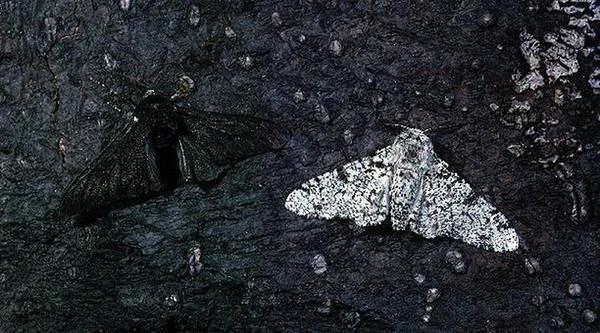
Natural selection, a fundamental concept introduced by Charles Darwin (1809-1882), is the mechanism by which certain genetic traits become more frequent in a population due to a selective advantage in a given environment. The emblematic example of this phenomenon is that of the peppered moth (Biston betularia), a species of moth whose wing color evolved in response to industrial pollution in the United Kingdom in the 19th century.
The peppered moth has two main forms: a light form with wings speckled with white and black, and a dark form called melanistic. The key role of wing color is predation by insectivorous birds, which more easily spot individuals that contrast with their visual background.
Physically, the visual perception of predators depends on the optical contrast between the moth and its environment, a function of the light reflection and absorption properties of the wings. In a clean natural environment, the trunks of birch trees are light and marked with spots, which favors the light form through cryptic camouflage. When industrial pollution covers the trunks with soot, the dark form becomes less visible.
The transformation of the peppered moth population, shifting predominantly from the light form to the dark form, took place over several decades. This time span depends essentially on the strength of the selective pressure exerted by the environment, that is, the advantage that the melanistic form has in escaping predation.
When industrial pollution darkened the tree trunks, the dark form became much better camouflaged, significantly increasing its chances of survival. The light moths, more visible against this dark background, were more often eaten by birds. This difference in survival led to a gradual increase in the proportion of dark moths in each generation.
The speed of this change also depends on the initial frequency of melanistic (dark) moths before pollution. Even if these individuals were rare initially, the strong selective advantage allowed them to multiply rapidly. Each successive generation had an increasingly higher proportion of dark moths.
Ultimately, this phenomenon occurred over several decades, which is relatively short on the scale of biological evolution. This case perfectly illustrates how natural selection can act quickly when the environment changes abruptly, favoring the best-adapted individuals.
The peppered moth perfectly illustrates the mechanism of natural selection through an observable, quantifiable, and physically modelable example. The correlation between industrial pollution, the optical properties of the wings, predation, and genetic dynamics shows the explanatory power of physics applied to evolutionary biology.